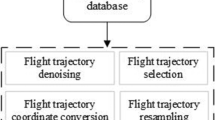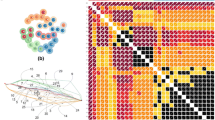Abstract
In order to efficiently mine the flight trajectory information in the terminal area and grasp the spatial distribution characteristics of the approaching traffic flow in the terminal area, this paper develops a flight trajectory data attribute correlation analysis model, and establishes a flight trajectory feature extraction model based on the data attribute correlation and improved k-means. Using the t-distributed stochastic neighbor embedding (t-SNE) method and density peaks clustering approach (DPCA), the prevailing traffic flow is then extracted. Finally, the real flight trajectory data in the terminal area are verified by analyzing the model parameters. The findings indicate that 788 flight trajectories are compressed to 100 trajectory points, divided into seven clusters, and seven prevailing traffic flows are extracted. Compared with the traditional flight trajectory clustering method, the accuracy of the method is improved by compressing the flight trajectory data scale and reducing the dimensionality. Simultaneously, the application of the DPCA method achieves a more detailed recognition of the flight trajectory.
Graphical Abstract



















Similar content being viewed by others
References
Hakak, S., Noor, N. F. M., Ayub, M. N., Affal, H., Hussin, N., & Imran, M. (2019). Data collection using unmanned aerial vehicles for Internet of Things platforms. Computers & Electrical Engineering, 75, 1–15. https://doi.org/10.1016/j.compeleceng.2019.01.028
Li, K., & Cheng, X. (2021). Design of a Conflict Prediction Algorithm for Industrial Robot Automatic Cooperation. Mobile Netw Appl. https://doi.org/10.1007/s11036-021-01819-0
Zhao, Y., Wang, C., Li, S. & Zhang, Z. (2017). Dependable Clustering Method of Flight Trajectory in Terminal Area Based on Resampling. Journal of Southwest Jiaotong University, 52, 817–825 and 834. https://doi.org/10.3969/j.issn.0258-2724.2017.04.022
Narayanan, S. J., Baby, C. J., Perumal, B., Bhatt, R. B., Cheng, X., Ghalib, M. R., et al. (2021). Fuzzy decision trees embedded with evolutionary fuzzy clustering for locating users using wireless signal strength in an indoor environment. International Journal of Intelligent Systems, 36, 4280–4297. https://doi.org/10.1002/int.22459
Shuai, L., Shuai, W., Xinyu, L., Chin-Teng, L., & Zhihan, L. (2021). Fuzzy detection aided real-time and robust visual tracking under complex environments. IEEE Transactions on Fuzzy Systems, 29, 90–102. https://doi.org/10.1109/TFUZZ.2020.3006520
Li, S., Cheng, X., Huang, X., Otaibi, S. A., & Wang, H. (2022). Cooperative Conflict Detection and Resolution and Safety Assessment for 6G Enabled Unmanned Aerial Vehicles. IEEE Transactions on Intelligent Transportation Systems. https://doi.org/10.1109/TITS.2021.3137458
Wang, C., Han, B. & Wang, F. (2014). Identification of prevalent air traffic flow in terminal airspace based on trajectory spectral clustering. Journal of Southwest Jiaotong University, 49, 546–552. https://doi.org/10.3969/j.issn.0258-2724.2014.03.027
Song, H., Wang, X., Hua, C., Wang, W., Guan, Q., & Zhang, Z. (2018). Vehicle trajectory clustering based on 3D information via a coarse-to-fine strategy. Soft Computing, 22, 1433–1444. https://doi.org/10.1007/s00500-017-2831-0
Namiki, Y., Ishida, T., & Akiyama, Y. (2013). Acceleration of sequence clustering using longest common subsequence filtering. BMC Bioinformatics. https://doi.org/10.1186/1471-2105-14-S8-S7
Xusong, L., Deping, H., Yu, X. & Zhenggang, L. (2018). Analysis of trajectory similarity and configuration similarity in on-the-fly surface-hopping simulation on multi-channel nonadiabatic photoisomerization dynamics. Journal of Chemical Physics, 149, 244104 (244117 pp.) https://doi.org/10.1063/1.5048049
Han, Z., Hong, L., & Geqi, Q. (2021). Analysis of Terminal Area Airspace Operation Status Based on Trajectory Characteristic Point Clustering. IEEE Access, 9, 16642–16648. https://doi.org/10.1109/ACCESS.2021.3053012
Yi, Z., Hongchang, L., Wenyong, F. & Haowen, D. (2008). Multi-radar tracking based on weighted k-means clustering fusion. In: 2008 IEEE International Conference on Granular Computing (GrC-2008), 26–28 Aug. 2008. IEEE Piscataway, NJ, USA, pp 813–816. https://doi.org/10.1109/GRC.2008.4664635
Zhijia, L., Wenjun, X., Li, G., Zhi, Z. & Jiaru, L. (2019). Flying Path Optimization of UAV for Wireless Power Transfer Systems: A Spectral-Clustering-Enabled Approach. In: 2019 IEEE 19th International Conference on Communication Technology (ICCT), 16–19 Oct. 2019. IEEE Piscataway, NJ, USA, pp 1220–1225. https://doi.org/10.1109/ICCT46805.2019.8947278
Nazari, M., Pashazadeh, S., & Mohammad-Khanli, L. (2019). An Adaptive Density-Based Fuzzy Clustering Track Association for Distributed Tracking System. IEEE Access, 7, 135972–135981. https://doi.org/10.1109/ACCESS.2019.2941184
Belhadi, A., Djenouri, Y., Djenouri, D., Michalak, T., & Lin, J. C. W. (2020). Deep Learning Versus Traditional Solutions for Group Trajectory Outliers. In IEEE Transactions on Cybernetics. https://doi.org/10.1109/TCYB.2020.3029338
Belhadi, A., Djenouri, Y., Srivastava, G., Cano, A., & Lin, J. C. W. (2021). Hybrid Group Anomaly Detection for Sequence Data: Application to Trajectory Data Analytics. In IEEE Transactions on Intelligent Transportation Systems. https://doi.org/10.1109/TITS.2021.3114064
Ahmed, U., Srivastava, G., Djenouri, Y., & Lin, J. C. W. (2021). Deviation Point Curriculum Learning for Trajectory Outlier Detection in Cooperative Intelligent Transport Systems. In IEEE Transactions on Intelligent Transportation Systems. https://doi.org/10.1109/TITS.2021.3131793
Liu, Y., Wang, H., Fan, J., Wu, J., & Wu, T. (2021). Control-oriented UAV highly feasible trajectory planning: A deep learning method, Aerospace Science and Technology, 110, 106435. https://doi.org/10.1016/j.ast.2020.106435
Dancila, R., & Botez, R. (2021). New flight trajectory optimisation method using genetic algorithms. The Aeronautical Journal, 125(1286), 618–671. https://doi.org/10.1017/aer.2020.138
Kim, M., Ko, J. U., Lee, J., Youn, B. D., Jung, J. H., & Sun, K. H. (2022). A Domain Adaptation with Semantic Clustering (DASC) method for fault diagnosis of rotating machinery. Isa Transactions, 120, 372–382. https://doi.org/10.1016/j.isatra.2021.03.002
Acknowledgements
This work was supported by the Fundamental Research Funds for the Central Universities and CAUC special fund under Grant 3122019129,and the National Key Research and Development Program of China (2020YFB1600101).
Author information
Authors and Affiliations
Corresponding author
Additional information
Publisher's Note
Springer Nature remains neutral with regard to jurisdictional claims in published maps and institutional affiliations.
Rights and permissions
Springer Nature or its licensor holds exclusive rights to this article under a publishing agreement with the author(s) or other rightsholder(s); author self-archiving of the accepted manuscript version of this article is solely governed by the terms of such publishing agreement and applicable law.
About this article
Cite this article
Wang, Zs., Zhang, Zy. & Cui, Z. Research on Resampling and Clustering Method of Aircraft Flight Trajectory. J Sign Process Syst 95, 319–331 (2023). https://doi.org/10.1007/s11265-022-01809-9
Received:
Revised:
Accepted:
Published:
Issue Date:
DOI: https://doi.org/10.1007/s11265-022-01809-9




